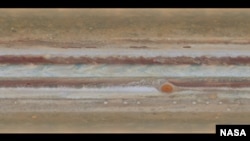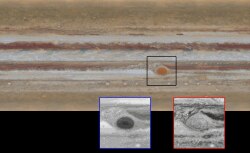Photos released by NASA reveal secrets about the biggest planet in the solar system, Jupiter.
The photos taken by the Hubble Space Telescope reveal a “rare” wave slightly north of the planet’s equator, according to NASA. The agency also says the images show a “filamentary feature” at the core of Jupiter’s famous Great Red Spot, a storm that has been swirling through the atmosphere for as long as Jupiter has been observed from Earth - over 400 years.
“Every time we look at Jupiter, we get tantalizing hints that something really exciting is going on,” said Amy Simon, a planetary scientist at NASA’s Goddard Space Flight Center in Greenbelt, Maryland, in a statement. “This time is no exception.”
One image, made using Hubble’s Wide Field Camera 3 shows “nearly back-to-back” rotations of the giant planet, allowing scientists to measure the speed of Jupiter’s winds.
The images also show that the Giant Red Spot is becoming smaller and more circular. The long axis of the storm is 240 kilometers shorter than it was in 2014, said the space agency.
The spot appears more orange than red and for the first time, researchers were able to detect a filamentary feature rotating within the spot. The photos show it being shaped by winds in excess of 150 meters per second.
The photos also gave scientists their first look at a wave in Jupiter’s northern equatorial belt, which had been seen by Voyager 2 in 1979, but not since.
“Until now, we thought the wave seen by Voyager 2 might have been a fluke,” said co-author Glenn Orton of NASA’s Jet Propulsion Laboratory in Pasadena, California. “As it turns out, it’s just rare!”
The images are part of NASA’s collection of annual photos, which the space agency hopes will allow scientists to see how planets change over time.
NASA is also compiling shots of Neptune and Uranus and will soon add Saturn as part of what the agency calls the Outer Planet Atmospheres Legacy program.
Here's an animation compiled by NASA:










